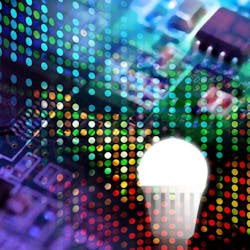Several test and measurement companies have instruments that are now capable of taking percent flicker and flicker index measurements for SSL products, and the US Department of Energy has found the products to be mostly accurate with a few notable exceptions.
Flicker continues to be an area of great concern in LED-based lighting with consequences for poorly-designed solid-state lighting (SSL) products ranging from headaches to seizures in extreme instances. While the industry moves to develop test methodologies for flicker, the US Department of Energy (DOE) has performed testing on three test and measurement (T&M) products that are claimed to be able to measure characteristics including percent flicker, flicker index, and fundamental frequency — parameters that have been defined in the Illuminating Engineering Society (IES) Handbook. A new report finds that the commercial flicker meters generally deliver accurate results, although there are notable exceptions based on situations such as sources with high fundamental frequencies or based on the configuration of the meters being tested.
Interested in more articles & announcements on test & measurement?
We covered the complexity of the flicker issues in a recent feature article. Flicker can be a problem with any lighting, and has been especially problematic with some LED-based products especially when dimming is involved. As the DOE noted, both the IES Testing Procedures Committee and the CIE (International Commission on Illumination) Technical Committee 1-83: Visual Aspects of Time Modulated Lighting Systems are pursuing potential standardized test methodologies to accurately characterize flicker.
Still, at least three T&M companies have added the capability of delivering the existing flicker metrics defined by the IES. The products include: the BTS256-EF Lightmeter from Gigahertz-Optik, the LFA-2000 Light Flicker Analyzer from Everfine, and the SC-ASTR-10 Illuminance Photometer from Admesy Asteria. The DOE sought to compare the operation of the products to a reference test system developed at the DOE's Pacific Northwest National Laboratory (PNNL) with that system comprising multiple instruments and a photosensor.
The DOE tested 14 SSL products that it had on hand with each of the three commercial test products and with its reference system. The sample luminaires included replacement lamps, troffers, downlights, and more. The samples included LED-based and fluorescent products. At least one of the LED-based products utilized AC-LED technology.
The results of the DOE testing are tough to simply quantify. Realize that such measurements are complex and involve detailed settings in the instruments. Moreover, once a light sample is captured, the equipment then performs a complex set of mathematical operations before delivering results in spreadsheet form. Most simply put, your results may vary based on how you set parameters such as measurement time and sample rate, and based on the performance of the source under test.
The DOE took two sets of measurements with each of the test equipment sets and each of the sample light sources. Short-duration tests used a 100-ms (millisecond) measurement time and long-duration tests used a 1s measurement time.
The biggest deviation in the results came in fundamental frequency measurements. Specifically, the DOE noted that huge differences in the results can happen with sources that have high-frequency content located far above the 120-Hz fundamental frequency that is predominant in many products that rectify the AC line. LED-based products that use pulsewidth modulation (PWM) to control light-intensity levels could fall into this group.
Still, fundamental frequency may be less significant than percent flicker and flicker index, especially for fundamental frequencies at 120 Hz and above. The DOE reported that 75% of the percent flicker measurements made by the commercial products were within 3% of the reference value. And 75% of the flicker index measurements were within 0.066. The nearby table summarizes the results.
The DOE summed up its tests saying that the commercial meters performed similar to one another and to the reference system in most cases. You can read the full results of the report on the DOE website.






